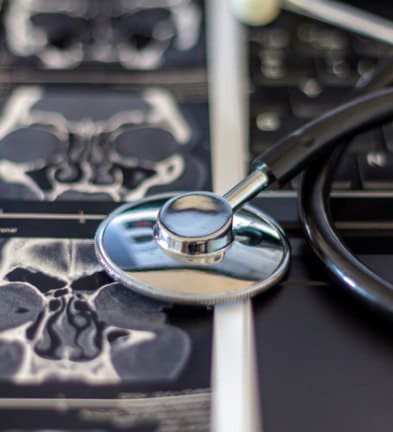Sinus infections bring pain and misery to millions of Americans. When the condition is chronic or recurs frequently and medications do little to provide relief, then sinus surgery is often recommended. There are a couple of different procedures available, each with the same goal in mind: to remove nasal obstructions and enlarge the sinus openings, enabling drainage of fluids.
Sinus surgery is far more commonplace now than in the past. Advances in medicine have led to procedures that are minimally invasive with little risk for complications.
What Sinus Surgery Options Are Available?
Depending on your condition, insurance, lifestyle and symptoms, your ENT physician may recommend one or more surgical treatment options. Some of the most common procedures we perform in-house or at our outpatient surgery center include:
Functional Endoscopic Sinus Surgery (FESS)
The goal of FESS is to open up the sinuses, allowing normal drainage of fluids to occur. Without proper ventilation, mucus builds up in the sinuses, leading to infection.
Who Is a Candidate for FESS?
To determine if you are a candidate for FESS, your doctor will thoroughly examine your ears, nose and throat, looking for obstructions and other abnormalities such as nasal polyps. If the odds of a successful surgery look promising, an appointment will be scheduled with a surgeon.
How is FESS Performed?
FESS is usually performed as an outpatient procedure under local anesthesia. An endoscope is inserted in the nose, and the camera is used to visually inspect the sinus openings. The surgeon relies on these images in order to remove excess obstructive tissue.
Balloon Sinuplasty
In this surgical procedure, a balloon catheter is inserted through the nostrils into the sinus passages, and gently inflated. This causes the sinus cavity to expand, allowing for easier drainage. The balloon is then deflated and removed. This operation is minimally invasive, provides immediate relief, and results in a much quicker recovery. Many patients are able to return to work the next day.
Endoscopic Sinus Surgery

The sinuses are hollow areas in the skull occupying the space above, between and below the eyes. They are connected to the nose and may become inflamed or infected leading to drainage, congestion, decreased sense of smell, fatigue, and pain. Underlying causes of inflammation may be air pollution, allergies, polyps, abnormal anatomy, reactions to viruses, fungus, and bacteria or swelling inside the nose.
Medications including nasal sprays, decongestants, antibiotics, antihistamines, and steroids may improve nasal and sinus symptoms. Sinus surgery is recommended only after appropriate medical therapy has failed to provide long term relief.
On rare occasion, immediate sinus surgery is needed. Sinus infections which have spread to the brain or eye, trauma and tumors of the nose or sinuses require surgical intervention without delay. Additionally, surgery may be the only option for some patients whose sinus disease worsens other medical problems such as asthma.
Current technology allows most sinus surgeries to be accomplished through the nostrils, without facial incisions.
This procedure is performed under general anesthesia. A CT scan of the sinuses is required before surgery. Sometimes a specialized three-dimensional computer navigation system is used along with surgery as a “GPS.” This may be necessary in revision cases or in patients with nasal polyps. This state-of-the-art technology provides the highest level of care to achieve the best possible outcome.
During surgery, small telescopes are gently inserted through the nostrils to view and magnify the nasal and sinus cavities on a video monitor. Dr. Liess uses delicate instruments to open and dilate the sinus drainage pathways. Irreversibly diseased tissue and obstructing bone fragments are carefully removed with these instruments under magnification. The essential principle in sinus surgery is to preserve as much healthy tissue as possible, allowing good recovery to normal function. Sinus surgery does not change the outward appearance of the nose but instead improves its function.
If infected sinus cavities are encountered, they can be drained and washed out during the procedure. Polyps, malignant and benign tumors, fungus balls and stagnant mucous buildup may also be removed. Rarely, tumors, trauma, and unusual infections may require an incision somewhere on the face for additional access.
Endoscopic sinus surgery may also utilize the balloon sinuplasty technique as a less traumatic approach in specific sinuses. Additionally, Propel ™ dissolving implants may be placed in sinus cavities with nasal polyps or significant inflammation to help with the healing process and decrease polyp formation.
Sinus surgery also allows for better delivery of topical medications for long term management of persistent symptoms. Sinus surgery may be combined with nasal septal surgery to relieve nasal obstruction and provide for better access to the sinuses.
Endoscopic surgery can also reduce enlarged turbinate tissue and further improve nasal breathing. This approach is done in a submucosal fashion which preserves the functional surface and decreases the bulky central part of the turbinate.
Patients go home the day of surgery. In the vast majority of procedures, nasal packing is not necessary. Mild nasal oozing is expected during the first several days.
Patients should begin rinsing the nose and sinuses with saline solution a few days after surgery. Patients can eat a regular diet and are allowed to perform light activity including walking the day after surgery. A follow up visit one or two weeks after surgery provides for cleaning of the nasal and sinus cavities. Most patients return to regular activity, including exercise regimens, in 14 days.
Call Benjamin Liess MD at (207) 415-4841 for more information or to schedule an appointment.